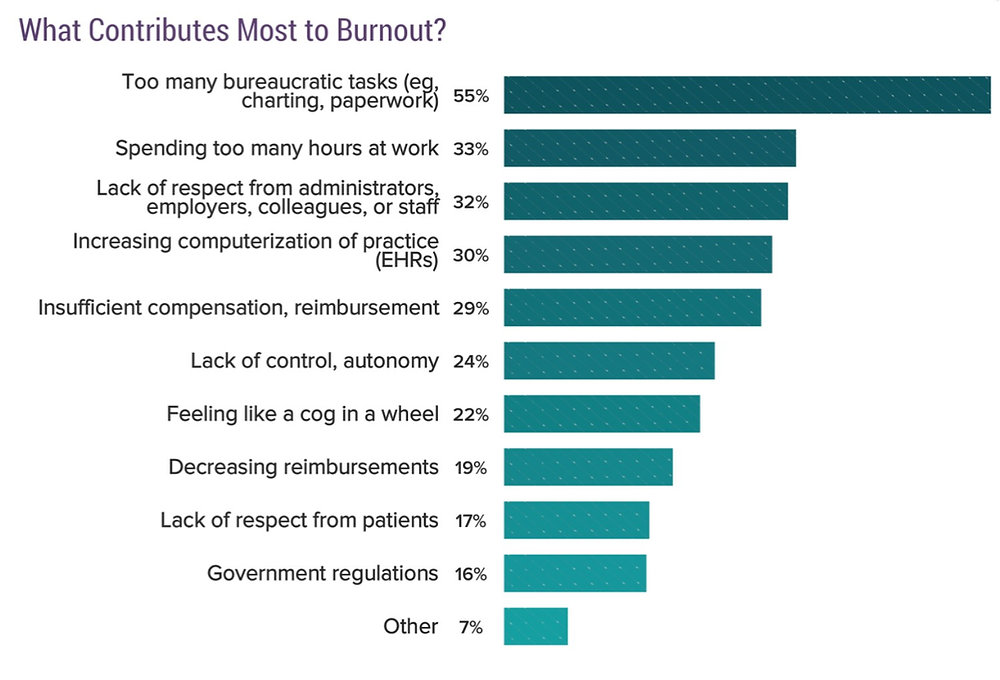For physicians, practicing medicine doesn’t just involve patient care but a variety of unnecessary tasks that contribute to their stress and frustration. Inefficient EHR systems create more work than necessary for physicians while repetitive paperwork is also a major complaint. Regulatory compliance, documentation, coding, quality control and the revenue cycle all require processes that add more administrative burden to a physician’s workload and takes time away from doing what they enjoy.
Federal agencies, Congress, and medical associations are all working to reduce administrative burden in the healthcare system. In 2016, the 21st Century Cures Act directed the Department of Health and Human Services to address administrative burden associated with the use of EHRs and other healthcare information technology. In 2020, the Centers for Medicare & Medicaid Services (CMS) created the Office of Burden Reduction and Health Informatics to simplify administration. Some of their efforts included eliminating excessive conditions of participation, simplifying the submission of data, and implementing faster processing of state requests.
Meanwhile, the American College of Physicians actively develops policy recommendations to help healthcare organizations identify and evaluate administrative tasks in an effort to reduce unnecessary complexity. In 2017, the American Academy of Family Physicians made “reducing administrative burden” their top strategic objective. AAFP currently fights for the issue through advocacy programs and by directly lobbying Congress, CMS, and health insurance companies.
Healthcare technology companies have also created many innovative solutions to address this challenge. Revenue cycle management software can automate workflows in billing and claims processing. Artificial intelligence products can automate a variety of processes that involve data. Mobile apps can improve coordination between many parts of the healthcare organization and on-the-go physicians.
“This isn’t why I went into medicine” is a resounding lament for physicians everywhere when speaking about paperwork. Every stakeholder in the healthcare industry recognizes the importance of reducing administrative burden to reduce inefficiencies, save time, and improve physician satisfaction.
How Kimedics Reduces Administrative Burden and Improves Physician Satisfaction
Kimedics is a workforce management system that streamlines many of the administrative processes in healthcare organizations. We set out to improve provider engagement by making the administrative aspects of their lives simpler.
One Source of Truth
Kimedics’ intuitive mobile app centralizes the provider’s information and makes it easy to schedule shifts with multiple healthcare organizations. Unlike the typical HR experience in which providers are filling out their information repetitively, physicians fill out a professional profile one time in our system that documents their education, employment, specialty, licenses, certifications, and references. It’s then used across the entire healthcare organization and can be sent to other organizations for hiring purposes through a secure document exchange with permissions. All of the physician’s licenses, credentials, privileges, and attestations are also uploaded once into the system, making it easy to schedule shifts with specialized qualifications.
Simple Scheduling That Saves Time
Approximately 30% of physicians take shifts at hospitals and practices that’s not their primary place of work. Most healthcare organizations are still using email to schedule provider shifts, meaning that providers must keep track of a huge number of emails in their inbox. It’s a confusing process that causes significant frustration for providers.
With Kimedics’ mobile app, there are no emails, spreadsheets, or file-sharing needed. All of the physician’s vital HR information is entered into the system once. Healthcare organizations know in real-time which physicians are available, what location they are currently working, and which physicians are qualified for a shift. The organization can show their providers open shifts, which they can then easily schedule for themselves with a click of a button. It’s also a simple process to swap shifts on the mobile app based on the availability of the qualified provider.
Reducing Errors in Payroll
Kimedics’ simple and intuitive system is capable of significantly reducing time and errors common to scheduling and the associated payroll processes. On average, medical groups see 20% of their pay statements come back from providers as errors---frustrating for providers and medical groups! Using email for scheduling causes a vast number of errors that can be dramatically reduced with a more efficient system. One healthcare organization that has adopted Kimedics had been spending eight hours a month just correcting errors in payrolls. Using Kimedics, they were able to reduce that to an hour. .
Interested in learning more about how Kimedics can improve your workforce management? Request more information.

